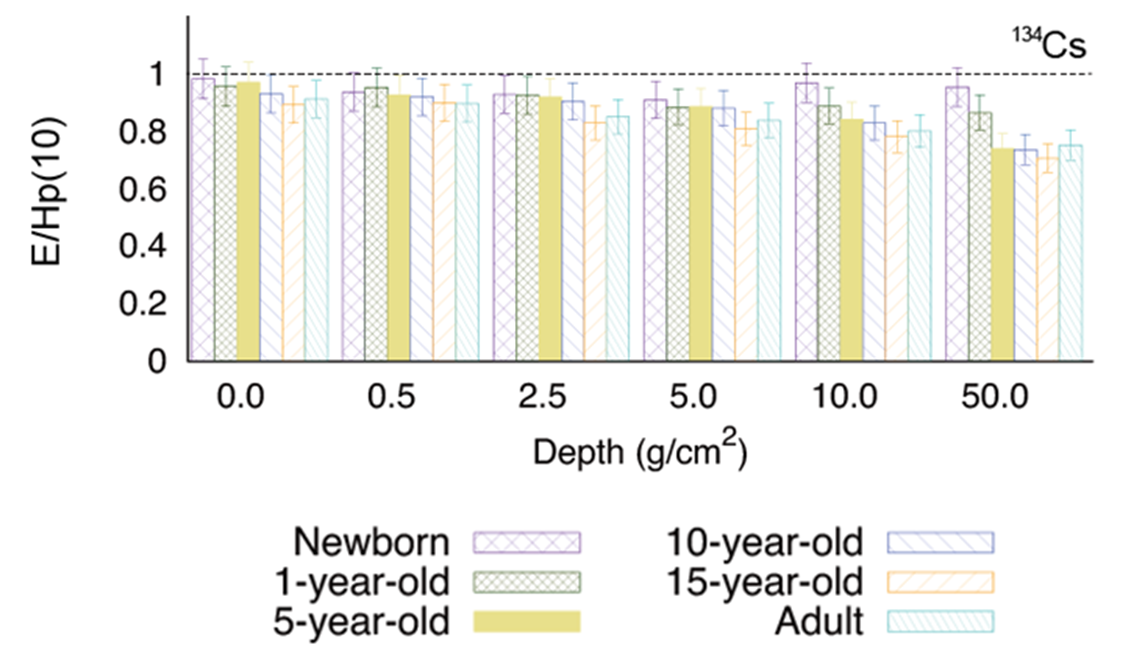Study
Dose assessment study on the basis of the 2007 recommendations of ICRP
Analyses of personal dose equivalent measured by dosimeters for radioactive cesium deposited in environment
|
A dosimeter is usually utilized to control radiation dose for a worker in a nuclear or a radiation facility.
Here, the dositmeter can give a radiation dose at a certain depth (in usual, 1 cm) at the position under the dosimeter, as a measured value.
The dose is defined as a personal dose equivalent.
The dosimeter is calibrated to indicate the personal dose equivalent through the irradiation from the frontal side.
Here, the dosimeter is put on a phantom that substitutes a human body.
It is known that we can reasonably estimate the radiation dose for the worker (that is called as "effective dose")
in a nuclear or a radiation facility with the measured personal dose equivalent without an underestimation
(Please see, "Radiation doses and their correlations for radiological protection"). Radiation dose measurement using dosimeters are conducted to grasp exposure dose to public following the TEPCO Fukushima Daiichi Nuclear Power Plant (FDNPP) accident. The irradiation condition is different between the facility and environment. A frontal irradiation may be dominant in the exposure to a worker in the facility, while a public may be exposed to radiations from various directions in an environment. Thus, we analyses correlations between effective dose and personal dose equivalent measured by a dosimeter that is put on chest surface of a human body in an environment with gamma-rays emitted from radioactive cesium [1]. Here, we utilizes a radiation transport calculation method that is developed for radiation dose estimation for radioactive materials in environment (Please see, "Estimation of radiation dose conversion coefficients for radionuclides in environment") and calculate personal dose measured by a dosimeter that is put on chest surface of a human body for various age groups (newborn, 1y 5y, 10y 15y and adult). It is confirmed that the calculated personal dose equivalents are close to the measured values in Fukushima prefecture. In addition, the results show that the personal dose equivalents can reasonably assess the effective doses for all of the age groups without underestimations. Nuclear Regulation Authority (NRA) in Japan stated that personal dose equivalent by dosimeter is referred as a basic benchmark value for returns to the areas where access restrictions are lifted in December, 2013. The results of our study may be useful to estimate effective dose from the measured value with a dosimeter for the public following the FDNPP accident. |
 |
| Fig.1: The correlations between the effective dose (E) and the personal dose equivalent (Hp(10)) for external exposure to the radioactive cesium (Cs-134) distributed in soil. *1 The effective doses for the pediatrics were computed according to the definition of the ICRP 2007 Recommendations. *2 The error bars are expressed in a form of one-standard deviation. |
[1] D. Satoh et al., J. Nucl. Sci. Technol., 54, 1018-1027, (2017).
[2] D. Satoh et al., Journal of Nuclear Science and Technology, 54, 1018-1027 (2017).
[3] D. Satoh et al., Journal of Nuclear Science and Technology, 53, 69-81 (2016).